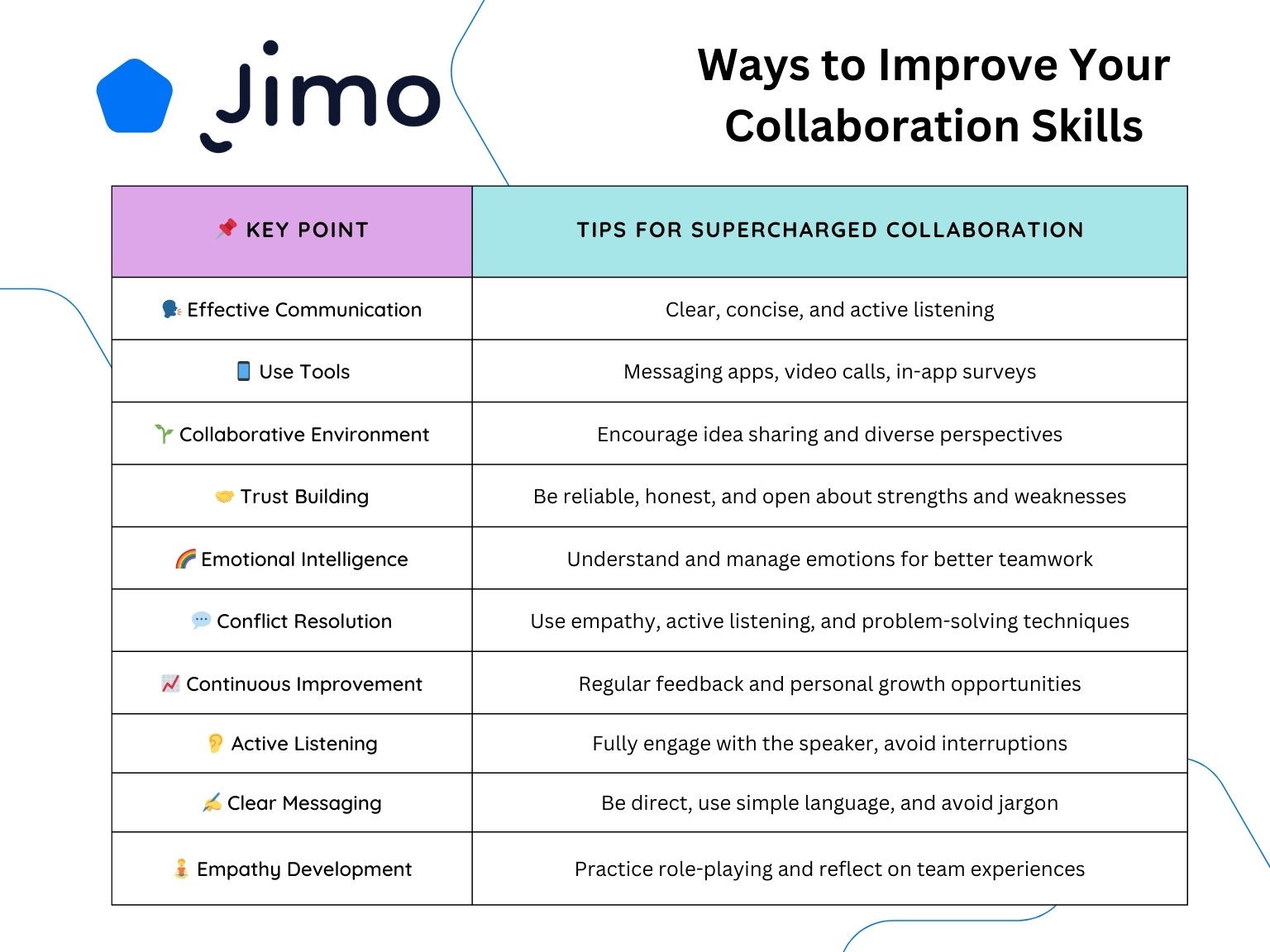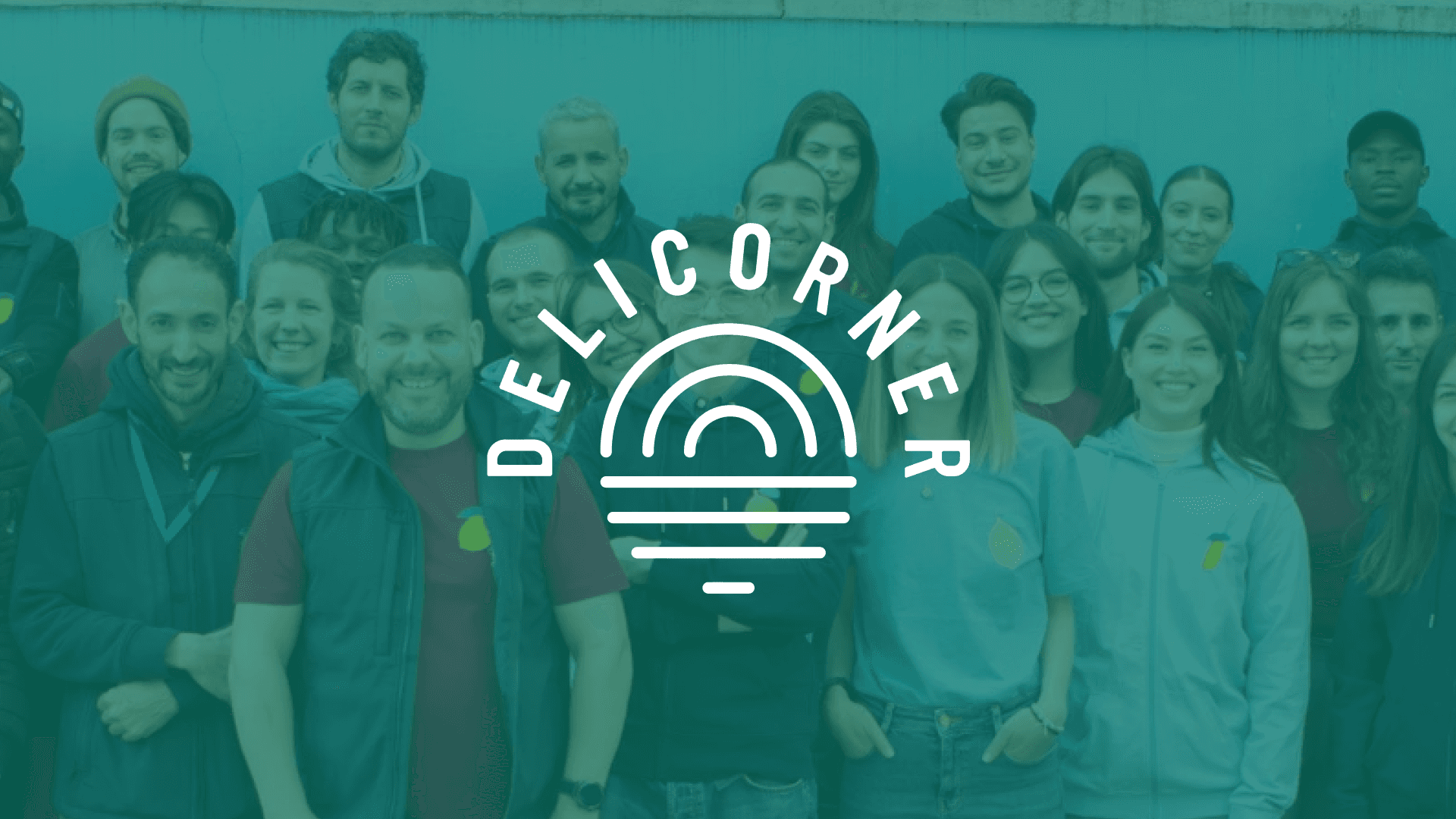Master Collaboration: Tips and Strategies for Effective Teamwork
Ready to supercharge your collaboration skills? Discover practical tips and powerful strategies to elevate your teamwork game. In this article, we'll dive into proven methods to enhance your collaborative abilities and transform your work environment. Get ready to unleash your potential and achieve unparalleled success through effective teamwork!
Key strategies for effective team collaboration
Since this article is lengthy, here's a quick recap of key strategies to enhance your teamwork and collaboration skills.

Building strong relationships with team members
The Importance of effective communication
Effective communication is the cornerstone of building strong relationships with team members. Clear and concise communication ensures that everyone is on the same page and understands their roles and responsibilities. It's not just about speaking clearly but also about active listening. When team members feel heard, they are more likely to be engaged and motivated.
Using tools like messaging apps, video calls, and in-app surveys can help facilitate smooth communication. These tools allow teams to share ideas, provide feedback, and address any concerns in real-time, promoting a culture of transparency and trust.
Fostering a collaborative environment
Creating a collaborative environment is essential for strong team relationships. This involves fostering a sense of belonging and ensuring that everyone feels valued. Encourage team members to share their ideas and opinions. Diverse perspectives often lead to innovative solutions and better decision-making.
Implement practices such as regular team meetings and brainstorming sessions. These activities not only enhance collaboration but also help in building rapport among team members. Recognize and celebrate team achievements, no matter how small, to boost morale and strengthen team bonds.
Building trust among team members
Trust is a fundamental element of strong team relationships. Without trust, collaboration efforts can quickly fall apart. To build trust, team members must be reliable and deliver on their commitments. Transparency and honesty in communication also play a crucial role in building trust.
Encourage team members to be open about their strengths and weaknesses. This vulnerability can lead to a more supportive and understanding team dynamic. Regular check-ins and one-on-one meetings can help build and maintain trust over time.
Developing emotional intelligence
Emotional intelligence (EI) is the ability to understand and manage your own emotions while also being aware of the emotions of others. High EI can significantly improve collaboration skills and help in building strong relationships with team members. It enables better conflict resolution, empathy, and effective communication.
Encourage team members to develop their emotional intelligence by providing training and resources. Practicing mindfulness and active listening can also enhance EI, leading to a more cohesive and harmonious team environment.
Implementing conflict resolution strategies
Conflicts are inevitable in any team setting, but how they are handled can make a significant difference in team dynamics. Effective conflict resolution strategies can prevent misunderstandings from escalating into larger issues and can even strengthen team relationships.
Teach team members conflict resolution techniques such as active listening, empathy, and finding common ground. Encourage a problem-solving mindset where the focus is on resolving the issue rather than blaming individuals. Having established protocols for addressing conflicts can also streamline the resolution process.
Encouraging Continuous Improvement
Continuous improvement is vital for maintaining strong relationships and effective collaboration within a team. Encourage team members to seek opportunities for growth and development both individually and as a group. This can involve taking courses, attending workshops, or participating in team-building activities.
Regularly assess team performance and seek feedback through methods like in-app surveys. Use this feedback to identify areas for improvement and implement necessary changes. By fostering a culture of continuous improvement, you ensure that the team remains dynamic, resilient, and cohesive.
Improving communication abilities
Effective collaboration hinges on strong communication skills. When team members can convey their ideas clearly and listen to others attentively, projects run more smoothly, misunderstandings are minimized, and innovation thrives. Communication is the cornerstone of any successful team effort, as it ensures everyone's contributions are valued and understood.
Active listening: the foundation of effective communication
One of the most critical aspects of enhancing communication abilities is mastering the art of active listening. Active listening involves fully concentrating on the speaker, understanding their message, responding thoughtfully, and retaining the information. This can be broken down into:
- Maintaining eye contact to show engagement.
- Nodding or providing verbal acknowledgments to indicate you are listening.
- Avoiding interruptions to allow speakers to finish their thoughts.
- Reflecting back what you’ve heard to confirm understanding.
By practicing active listening, team members can foster a more inclusive and respectful environment where everyone feels heard.
Clear and concise messaging
In collaborative settings, clarity and conciseness are paramount. The ability to express your thoughts in a straightforward manner can prevent miscommunications and ensure everyone is on the same page. To improve clarity, consider the following tips:
- Use simple language and avoid jargon.
- Be direct and to the point.
- Organize your thoughts before speaking or writing.
- Use visual aids if necessary to illustrate complex points.
Clear messaging helps in reducing ambiguity and makes it easier for others to provide input or ask relevant questions.
Utilizing In-App surveys for feedback
Gaining feedback is crucial for continuous improvement. By using tools like our in-app surveys tool, teams can collect insights on communication effectiveness. These surveys provide an easy way for team members to share their thoughts on collaboration processes and suggest areas for improvement. Gathering regular feedback ensures that communication strategies remain adaptable and effective.
Encouraging open dialogue
Open dialogue is essential for healthy team dynamics. Encouraging team members to voice their ideas, concerns, and suggestions without fear of judgment creates a more collaborative environment. Techniques to promote open dialogue include:
- Holding regular brainstorming sessions.
- Creating a safe space for feedback.
- Encouraging diverse viewpoints.
- Being approachable and receptive to new ideas.
When open dialogue is promoted, team members are more likely to contribute constructively and work together to overcome challenges.
Nonverbal communication: reading between the lines
Nonverbal communication, such as body language, facial expressions, and tone of voice, plays a critical role in collaboration. These cues can convey feelings and attitudes that words alone might not express. To enhance nonverbal communication:
- Be aware of your own body language and what it might be conveying.
- Observe the nonverbal cues of others to understand their emotional state.
- Ensure your nonverbal signals match your verbal messages.
- Practice empathy by considering how others might perceive your actions.
Being mindful of nonverbal communication helps build stronger connections and fosters a more cohesive team.
Developing emotional intelligence
Emotional intelligence (EQ) is the ability to understand and manage one’s own emotions and those of others. High EQ contributes significantly to effective communication within a team. To develop emotional intelligence:
- Practice self-awareness to understand your emotional triggers.
- Learn to manage and regulate your emotions.
- Develop empathy by actively putting yourself in others' shoes.
- Improve social skills to build better relationships.
Enhanced emotional intelligence leads to more positive interactions and reduces conflicts, paving the way for smoother collaboration.
Developing empathy and understanding
Empathy in collaboration
Empathy is the ability to understand and share the feelings of others. In the context of teamwork, empathy allows for deeper connections and more effective communication among team members. By fostering empathy, team members can better anticipate each other’s needs and concerns, which leads to smoother interactions and better collaboration.
Developing empathetic listening skills
One of the foundational aspects of empathy is the ability to listen actively and attentively. Empathetic listening involves paying close attention to what is being said, acknowledging the speaker's feelings, and responding thoughtfully. This kind of listening can be developed by practicing the following:
Maintaining eye contact
Not interrupting the speaker
Summarizing what the speaker has said to confirm understanding
Asking open-ended questions to encourage further discussion
Cultivating an open and accepting mindset
A crucial component of empathy is maintaining an open and accepting mindset. This means being open to different viewpoints and not passing judgment prematurely. Team members should strive to respect each other's opinions and experiences, even when they differ from their own. This approach helps in creating a supportive and inclusive environment where everyone feels valued.
The role of in-app surveys in gauging team sentiments
Utilizing tools like our in-app surveys and NPS no code solution can help teams gauge the emotional and psychological states of their members. These surveys can provide insights into how team members feel about various aspects of their work, from project timelines to interpersonal dynamics. Gathering this data allows leaders to address any issues promptly and foster a more empathetic and understanding team culture.
Practicing empathy through role-playing
Role-playing exercises can be an effective way to practice empathy in a controlled setting. By putting themselves in others' shoes, team members can gain a better understanding of different perspectives and challenges. These exercises can lead to increased empathy and can improve how team members interact with each other in real-world scenarios.
Implementing team building activities
Team building activities can help in developing empathy and understanding among team members. Activities that require collaboration and communication can strengthen interpersonal bonds and improve team dynamics. These activities provide a platform for team members to interact in a more relaxed setting, which can lead to stronger relationships and better teamwork.
Reflecting on team experiences
Taking time to reflect on team experiences and interactions can also help in building empathy. Encourage team members to share their reflections on what went well and what could be improved. This reflection process can reveal insights into individual and team behaviors, helping everyone to become more empathetic and understanding.
Encouraging open and honest feedback
Leading by example
Leadership plays a critical role in modeling the behavior they wish to see in their teams. For open and honest feedback to become a norm, leaders must demonstrate it themselves. This means being transparent about their own challenges and welcoming constructive criticism. By doing so, they set a precedent and encourage team members to mirror this behavior. Leaders should also provide positive reinforcement when team members share honest feedback, further promoting a culture of openness.
Providing constructive feedback training
To ensure that feedback is both open and honest, it is essential to train team members on how to provide constructive feedback effectively. This type of feedback focuses on specific behaviors rather than personal attributes, making it easier for the recipient to understand and act upon. Training sessions and workshops on constructive feedback can be highly beneficial. These sessions might cover topics such as:
How to frame feedback in a non-confrontational manner
Using "I" statements to express personal observations and feelings
Focusing on solutions rather than merely highlighting problems
Encouraging Peer-to-Peer feedback
While feedback from leaders is important, peer-to-peer feedback can be just as valuable. It fosters a sense of camaraderie and mutual respect among team members. Creating opportunities for peer reviews, brainstorming sessions, and collaborative projects can facilitate this type of feedback. Encourage team members to share their thoughts and suggestions with each other directly and provide guidelines to ensure the feedback remains constructive and supportive.
Utilizing anonymous feedback tools
Sometimes, team members may feel hesitant to provide honest feedback due to fear of reprisals or hurting someone's feelings. To overcome this, consider incorporating anonymous feedback tools into your team's processes. These tools allow individuals to share their thoughts without any identifying information, making it easier for them to be candid. For instance, the use of in-app surveys can provide valuable insights while maintaining anonymity, helping to build trust and openness within the team.
Setting clear expectations
Clarifying the expectations around feedback is vital for it to be effective. Team members should understand that feedback is not about personal criticism but about improving processes, performance, and collaboration. Establish clear guidelines and norms for providing and receiving feedback, and ensure everyone is on the same page. By setting these expectations, you create a smoother feedback process where team members feel more comfortable being open and honest.
Utilizing technology for better collaboration
Best communication tools
Software like Slack, Microsoft Teams, and Zoom have revolutionized the way teams communicate. These platforms facilitate real-time chatting, video conferencing, and file sharing, enabling seamless collaboration irrespective of geographical boundaries. Adopting these tools encourages open communication, ensures that everyone is on the same page, and helps in swiftly addressing issues and brainstorming solutions.
Leveraging project management software
To improve collaboration, leveraging project management software is essential. Platforms such as Asana, Trello, and Monday.com provide a structured way to manage tasks and projects. These tools enable team members to assign tasks, set deadlines, and monitor progress in real-time. The visual representation of tasks helps in understanding who is responsible for what, fostering accountability, and ensuring that projects stay on track.
Utilizing cloud storage solutions
Cloud storage solutions like Google Drive, Dropbox, and OneDrive help in centralizing documents and files. With cloud storage, teams can effortlessly access and share documents, spreadsheets, and presentations from anywhere in the world. This not only promotes transparent information sharing but also ensures that everyone has the latest version of a document, minimizing the risk of errors and duplications.
Integrating collaborative platforms
Collaborative platforms such as Miro and Mural offer virtual whiteboards that are perfect for brainstorming sessions and creative collaborations. These tools provide features like sticky notes, drawing tools, and templates that mimic physical brainstorming techniques. By adopting these platforms, teams can enhance their collaborative creativity, capture innovative ideas, and refine concepts in a shared space.
Real-time collaboration with document editing tools
Document editing tools like Google Docs and Microsoft Office 365 allow multiple team members to work on the same document simultaneously. Real-time collaboration features enable instant updates and edits, making it easier to co-author reports, proposals, and other documents. This fosters a collaborative environment where input from various team members can be quickly integrated, producing more comprehensive and polished outputs.
Employing time management applications
Effective time management is integral to successful collaboration. Apps such as Toggl, Clockify, and RescueTime help individuals and teams track time spent on various tasks. By analyzing time usage patterns, teams can identify inefficiencies and allocate time resources more effectively. This ensures that each team member is working efficiently and collaboratively towards the common goal.
Strategies for conflict resolution
Conflict is inevitable in any team setting, but how it is managed can significantly impact the outcome of collaborative efforts. Effective conflict resolution skills help in addressing disagreements constructively, preventing them from escalating into bigger problems. These skills contribute to a healthier work environment where all team members feel valued and understood.
Implementing effective conflict resolution strategies is crucial for maintaining team harmony:
Address Issues Early: Deal with conflicts as they arise to prevent them from becoming unmanageable.
Stay Calm and Composed: Emotional reactions can escalate conflicts, so it is important to remain calm.
Focus on the Issue, Not the Person: Address the problem without making it personal.
Communicate Openly: Encourage honest and respectful dialogue.
Seek Mediation if Necessary: Sometimes a neutral third party can help facilitate resolution.
By implementing these strategies, you can transform your collaboration skills and foster a more dynamic, successful work environment. Remember, building strong relationships, improving communication, and developing empathy are key to effective teamwork. Embrace these practices, and watch your team's synergy and productivity soar. Good luck, and here's to achieving unparalleled collaboration!





